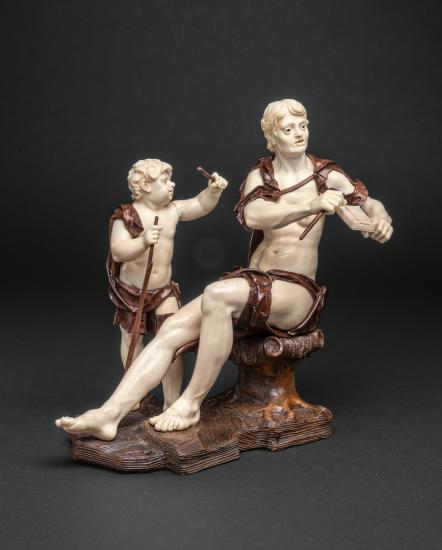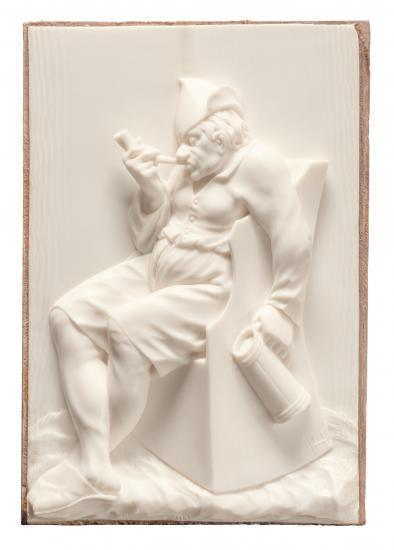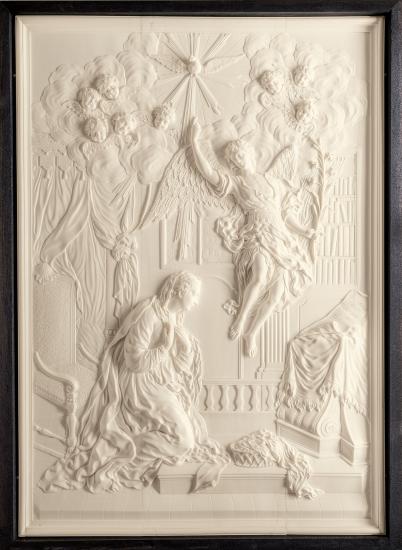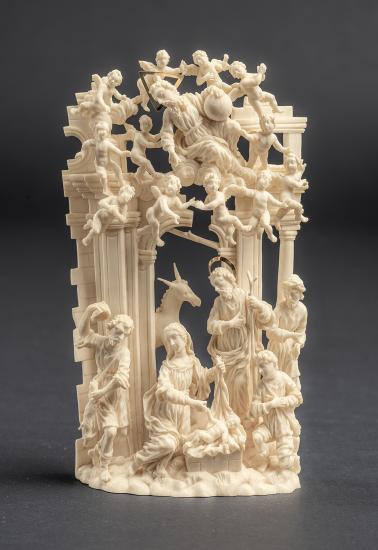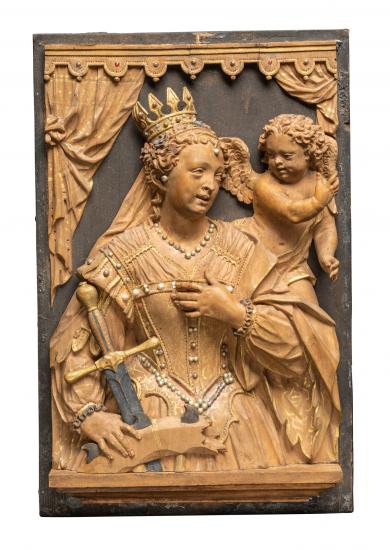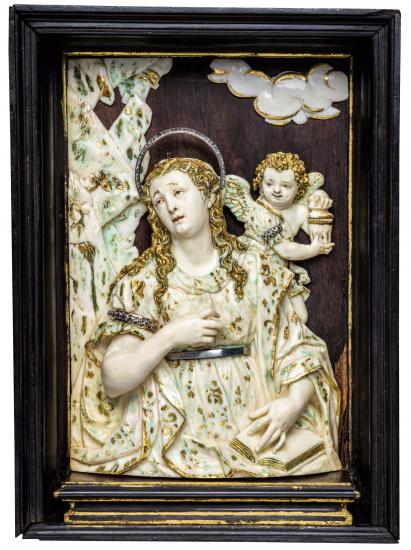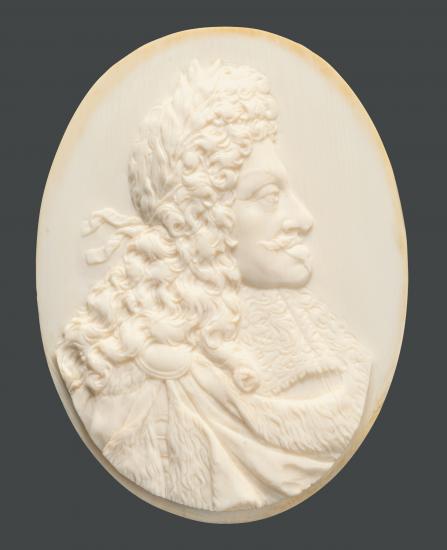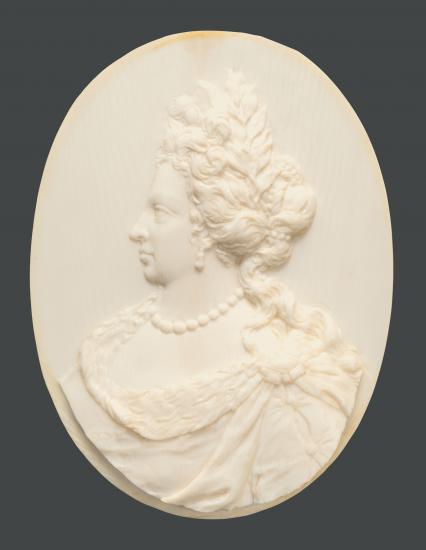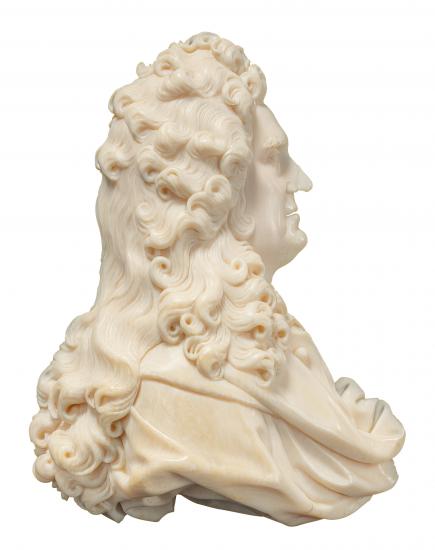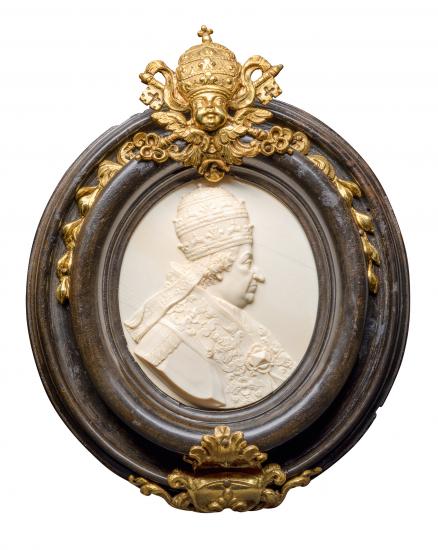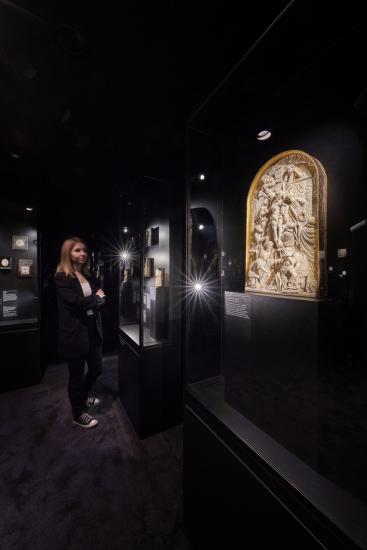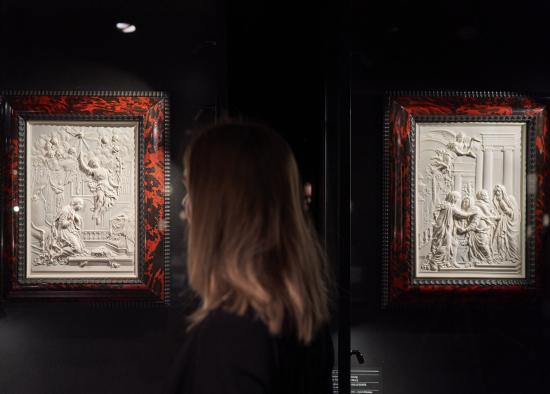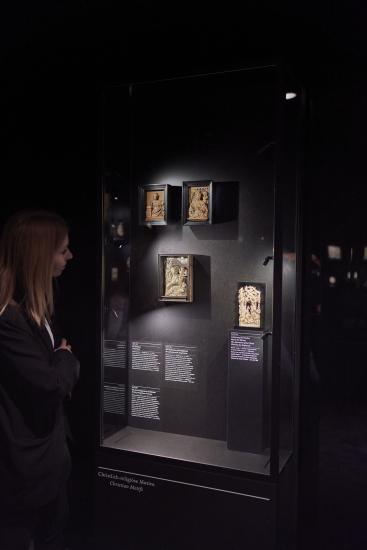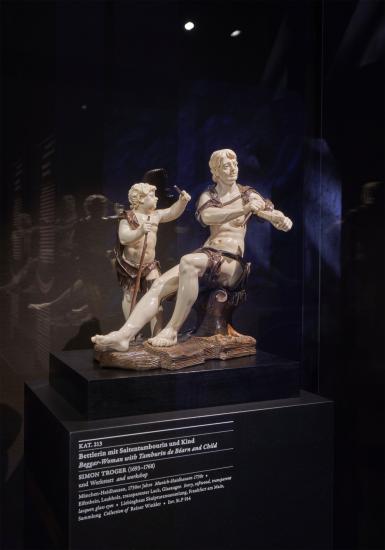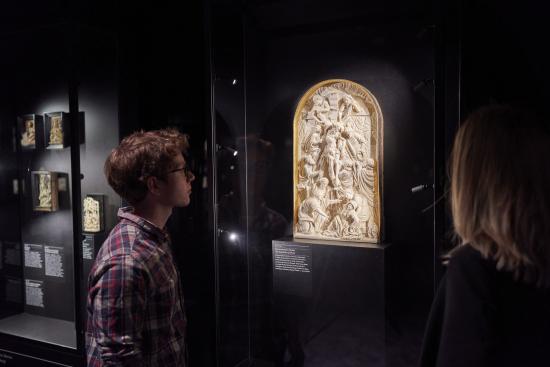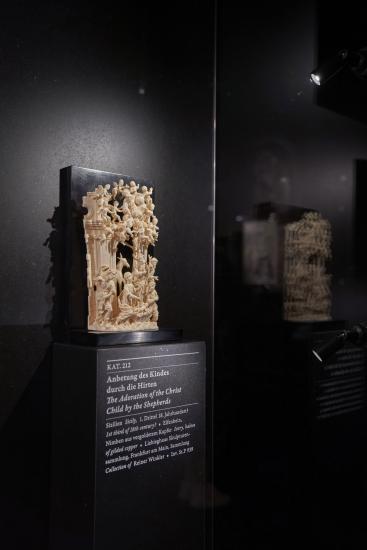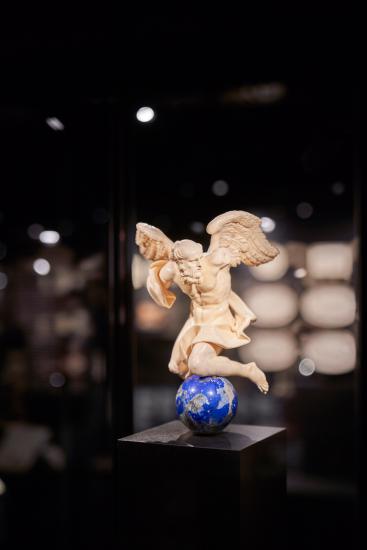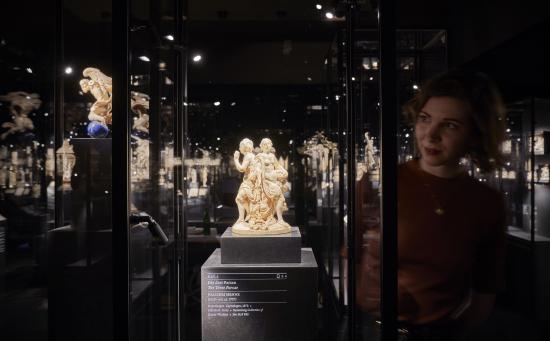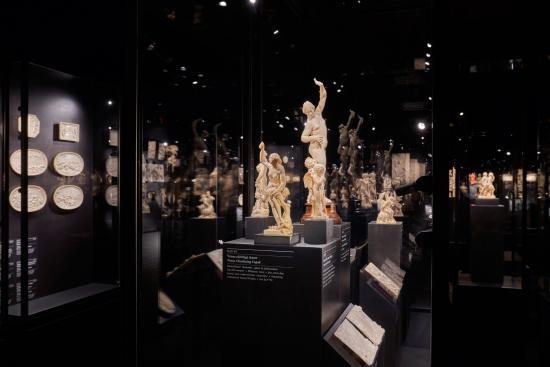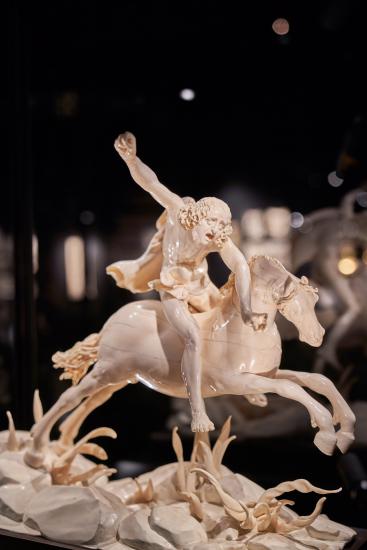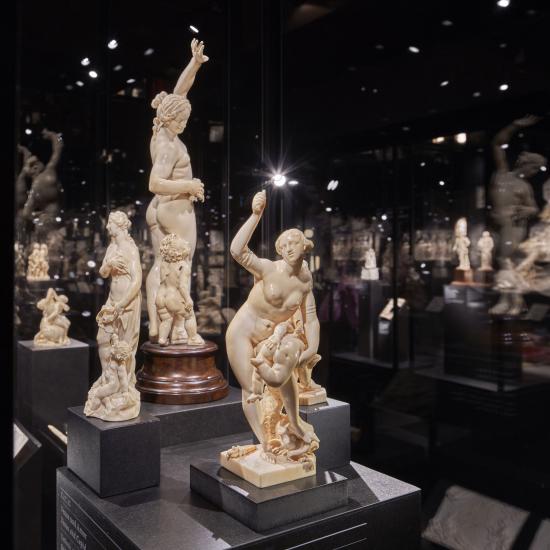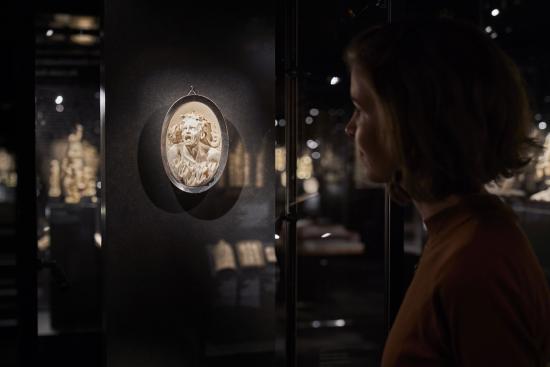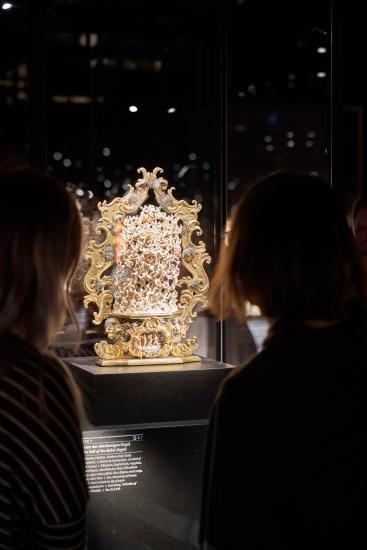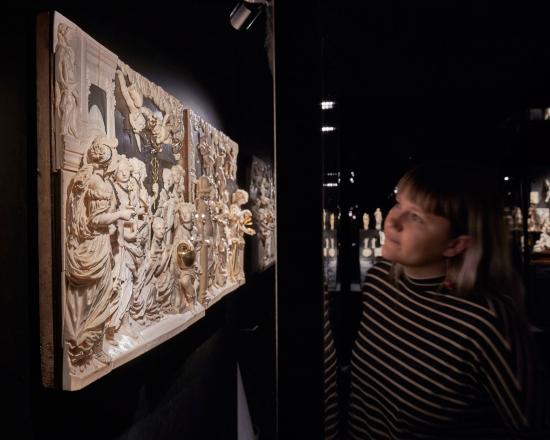The Reiner Winkler Ivory Collection in the Liebieghaus is complete
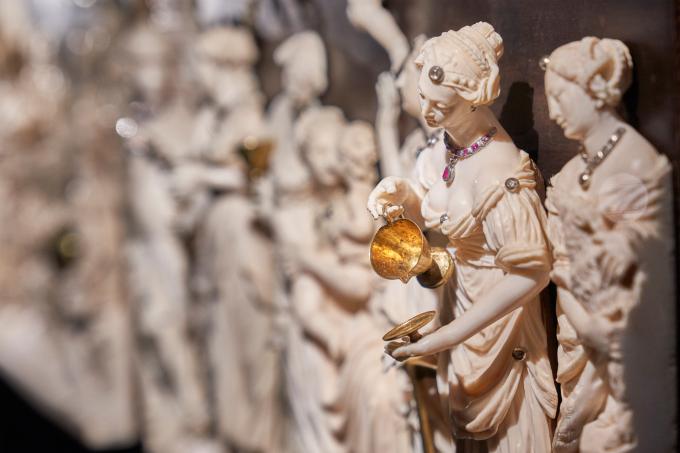
As of 2 June, the Liebieghaus will present more than 200 precious ivory sculptures of the Baroque and Rococo periods in the exhibition “Splendid White”
Press texts
Press release
The Reiner Winkler Ivory Collection in the Liebieghaus is complete
As of 2 June, the Liebieghaus will present more than 200 precious ivory sculptures of the Baroque and Rococo periods in the exhibition “Splendid White”
A few years ago, the Liebieghaus Skulpturensammlung succeeded in making the most significant addition to its own holdings in the history of the museum: a collection of precious ivory sculptures of the Baroque and Rococo periods from the estate of the patron Reiner Winkler (1925–2020). The Ernst von Siemens Kunststiftung, the Städelsche Museums-Verein, and the Städel Museum, with the support of the Kulturstiftung der Länder and the Hessische Kulturstiftung, acquired this unique collection, which was made possible in the first place by Reiner Winkler’s generous donation of the majority of the collection. Since then, masterpieces by world-famous sculptors, such as Fury on a Charging Horse (1610), The Three Parcae (ca. 1670), Chronos on the Globe (ca. 1720/25?), and the Allegory of Damnation in Hell (Anima Dannata?) (1736) have been on display at the Liebieghaus in the exhibition “White Wedding.”
With the exhibition and new collection presentation “Splendid White,” the Reiner Winkler Ivory Collection at the Liebieghaus is now complete: as of 2 June 2022, more than 200 historical ivory works will be presented – including a further twenty-one outstanding works of art that remained in the private collection of Reiner Winkler until his death and are now accessible to the public for the first time. In the new collection presentation, the beauty, virtuosity, and richness of variation of baroque ivory carving can be experienced in an impressive way. The last works of art to be displayed and hung in the patron’s private home, including portrait medallions, large-format reliefs with Christian religious motifs and genre scenes, as well as an impressive combination figure, add essential exhibits to the previous collection presentation at the Liebieghaus. The portrait of a pope and larger series of stately portraits expand the portrait section. In addition, the art landscapes of Sicily and Dieppe, as well as the oeuvres of pioneering sculptors and sculptor families, including, for example, Paul Herrmann and the two carvers Carl August Lücke the Elder and the Younger, can also be expanded. In addition, the close connection of ivory art with exemplary graphic or folk art becomes clear, making cultural-historical connections more visible.
Download the complete press release here.
Press Release
The Liebieghaus Skulpturensammlung is to be enriched by a magnificent addition: The Ernst von Siemens Kunststiftung, the Städelscher Museums-Verein, and the Städel Museum, with the support of the Kulturstiftung der Länder and the Hessische Kulturstiftung, have acquired for the Liebieghaus Skulpturensammlung a collection of over 200 valuable ivory sculptures owned by Reiner Winkler. With this acquisition, which was made possible through the generous gift of a large part of the collection by Reiner Winkler, the Liebieghaus has achieved the most important expansion of its own holdings in the history of the museum. From 27 March 2019, some 190 artworks will be shown on view in the exhibition “White Wedding: The Reiner Winkler Ivory Collection Now at the Liebieghaus – Forever.” The ivory works from the Middle Ages and the Baroque and Rococo periods will be presented in theme-based chapters.
Over the decades, the collector and patron Reiner Winkler (b. 1925) has assembled a legendary private collection of ivory sculptures with a focus on Baroque masterpieces. One outstanding work is, for example, Fury on a Charging Horse (1610). Further masterpieces in the collection are The Fall of the Rebel Angels (first third of the 18th century) from Southern Italy/Sicily, The Three Parcae (ca. 1670) by Joachim Henne (1629‒ca. 1707), and Francis van Bossuit’s (1635–1692) Mercury, Argus and Io (ca. 1670/75?), as well as important sculptural works by Johann Caspar Schenck (ca. 1620‒1674), Balthasar Grießmann (ca. 1620–1706), and Matthias Steinl (1643/44–1727). The unique compilation of works provides the Liebieghaus Skulpturensammlung with the opportunity to expand its own internationally important collection at the very highest level. The acquisition also establishes European ivory art as a central focus of the collection in the Baroque and Rococo department at the Liebieghaus—a focus which, in the future, will be the subject of in-depth academic research and education.
“Reiner Winkler’s collection is not only the world’s largest private collection of ivory sculptures; it is also unique for its particular art-historical significance. We are delighted and immensely grateful to Mr. Winkler that his collection will now find a new home in the Liebieghaus Skulpturensammlung—in the very place that Reiner Winkler had long imagined for his artworks. The patron’s assignment of the collection at an extremely generous price is tantamount to the gift of most of the pieces and has made this most important addition to the holdings in the history of the museum possible. With the collection of Reiner Winkler, the Liebieghaus has been granted not only a new area of focus within the collection, but also the opportunity to considerably expand the international significance and profile of the Liebieghaus,” explained Philipp Demandt, Director of the Liebieghaus Skulpturensammlung and the Städel Museum.
Reiner Winkler has been building up his collection continuously since 1962. After several years of collecting sculptures of various materials and periods, he soon decided to concentrate on ivory sculptures of the 17th and 18th centuries, and as well as, to a considerably lesser extent, the early 19th century. Winkler has maintained a close relationship with the Liebieghaus Skulpturensammlung for many years. On a number of occasions in the past he has generously provided the museum with loans for exhibitions.
Reiner Winkler commented on the transfer of his collection to the museum: “I am very happy that my collection will find a new and permanent home in the Liebieghaus and will therefore continue to exist as a ‘Gesamtkunstwerk.’ I have been pursuing this idea for many years now, since I am convinced that, in this way, it will be possible to achieve a wonderful symbiosis. The framework is ideal, as regards both the setting and art history. Then there is the perfect manner in which the areas of focus of the collection blend with the academic expertise of the museum, the proximity to our home town of Wiesbaden and, last but not least, the enthusiasm and the wonderful commitment of all those involved. This has strengthened my conviction that every single work will find a superb new home here and that there cannot be a better permanent place for my collection than the Liebieghaus. I am proud and delighted that uniting the existing collection of Baroque and Rococo art in the Liebieghaus with my collection will now transform the museum into a place where internationally important sculptures will be made accessible to the public as in no other location, and I hope that many visitors will experience great pleasure in viewing the exhibits.”
The acquisition was made possible by the Ernst von Siemens Kunststiftung, the Städelscher Museums-Verein, and the Städel Museum with the support of the Kulturstiftung der Länder and the Hessische Kulturstiftung.
The President of the Städelscher Museums-Verein, Sylvia von Metzler, is delighted “that the Städelscher Museums-Verein as an important patron of the acquisitions for the Städel Museum and the Liebieghaus Skulpturensammlung was able to make a significant contribution towards the acquisition of this unique collection.”
“Our support for the acquisition of the exquisite Winkler ivory collection is the largest financial sponsorship which the Ernst von Siemens Kunststiftung has undertaken in recent years, since the foundation covered almost half of the philanthropic purchase price. Our founder was a businessman and patron of the arts, and he would have appreciated the hands-on manner in which the enthusiastic and generous collector and the Liebieghaus have taken advantage of this unique opportunity to bring about a substantial expansion of the collection,” observed Dr. Martin Hoernes, Secretary General of the Ernst von Siemens Kunststiftung.
Eva Claudia Scholtz, Managing Director of the Hessische Kulturstiftung, confirmed: “The Hessische Kulturstiftung is delighted that, through its involvement, one of the most remarkable collections of Baroque sculptures in private ownership can now be made permanently accessible to an audience from Germany and abroad in the Liebieghaus in Frankfurt.”
As a first step, the Kulturstiftung der Länder supported the acquisition of the Fury on a Charging Horse. Additional support for the entire collection is subject to the approval of the next meeting of the Board of Trustees of the Kulturstiftung der Länder. Prof. Dr. Markus Hilgert, Secretary General of the Kulturstiftung der Länder: “It is most fortunate that a museum such as the Liebieghaus is able to acquire a collection as complete as this one and at the same time to come across an collector whose expertise and passion for art is linked to the conviction that such magnificent treasures should remain accessible to the public. It was a similar conviction which, in the past, led to the founding of the Kulturstiftung der Länder, which is why we are delighted to support this acquisition.”
The Collection
The Reiner Winkler Collection concentrates on works from the 17th and 18th centuries, the golden age of the art of ivory carving. It contains a large number of English, French, Italian, German, Spanish, Austrian, Dutch, and Flemish ivory sculptures, as well as two works from India and China. They include statuettes, groups of figures, reliefs, medallions, and a small number of tankards and ceremonial vessels. “With the works from the Reiner Winkler Collection, visitors to the Liebieghaus can appreciate fine and top-quality artworks of European sculpture during the Baroque and Rococo periods that cover a truly remarkable range,” observed Dr. Maraike Bückling, Head of Collections in the Renaissance to Classicism department and curator of the exhibition. The works in the extensive collection provide an impressive overview of the history of Baroque ivory art. In addition, the various features of ivory carving within Europe are shown in an impressive manner.
In some areas, the collection of the Liebieghaus and the Reiner Winkler Collection complement each other, as for example in the works by the artists of the Schenck family. The Liebieghaus owns an ivory relief, The Archangel Michael Fighting the Devil (1683) by Christoph Daniel Schenck (1633–1691). The Reiner Winkler Collection boasts several outstanding works by this family of artists, including an exquisite Allegory of Summer (ca. 1666), created by an older relative of Christoph Daniel, Johann Caspar Schenck (ca. 1620–1674).
While the Liebieghaus possesses a small ivory relief identified as belonging to the circle of the Netherlandish artist Gérard van Opstal (1594/97–1668), the Reiner Winkler Collection now adds two further works from his vicinity, one of which may have belonged to King Louis XIV. One of the most important artists of the 17th and 18th centuries was the Austrian Matthias Steinl (1643/44–1727). The holdings of the museum include an unusual wooden statue of Maria Immaculata (1688), while the Reiner Winkler Collection contains Steinl’s small, masterfully worked ivory statuette Chronos on the Globe (ca. 1720/1725?).
Masterpieces by famous sculptors such as Adam Lenckhardt (1610–1661), Balthasar Grießmann (ca. 1620–1706), Thomas Schwanthaler (1634–1707), Francis van Bossuit (1635–1692), David Le Marchand (1674–1726), Jean Cavalier (ca. 1650/60‒1698/99), Joachim Henne (1629‒ca. 1707), Theophilus Wilhelm Freese (1696–1763), Johann Christoph Ludwig Lücke (ca. 1703‒1780), and Simon Troger (1693–1768) will be finding their way into the Liebieghaus Sculpture Collection following the acquisition of the Reiner Winkler Collection.
The Exhibition
With the exhibition “White Wedding: The Reiner Winkler Ivory Collection Now at the Liebieghaus – Forever.”, the Liebieghaus Skulpturensammlung presents almost all the pieces from the Reiner Winkler Collection, thereby demonstrating their artistic range. The works within the collection enter into a dialogue with objects from the museum’s own collection. Ivory works from the Liebieghaus are juxtaposed with those from the Reiner Winkler Collection, and museum exhibits by the same artists but made of other materials are also on view. Some 190 exhibits trace the history of small sculpture in the Baroque and Rococo ages.
Certain masterpieces from the Reiner Winkler Collection are the subject of a special focus within the exhibition. These include, for example, Fury on a Charging Horse (1610) by the so-called Master of the Furies (active ca. 1600–1625), a central work from the Reiner Winkler Collection. Also on view are The Three Parcae (ca. 1670) by Joachim Hennes, Francis van Bossuit’s Mercury, Argus and Io (ca. 1670/75?), the relief panels carved by an unknown Augsburg sculptor Minerva introducing Sculpture and Painting to the seven Free Arts (second half of the 17th century), as well as the Depiction of eight Cardinal Virtues (second half of the 17th century), together with Matthias Steinl’s Chronos on the Globe (ca. 1720/25?), the Allegory of Damnation in Hell (1736) by Johann Christoph Ludwig Lücke, and the Fall of the Rebel Angels (first third of the 18th century), carved by an unknown ivory artist from southern Italy or Sicily.
Germany and Austria played an important role in ivory art, as can be clearly seen in the Reiner Winkler Collection. Therefore important artists such as Leonhard Kern (1588‒1662), Georg Pfründt (1603‒1663), Jacob Dobbermann (1682–1745), the Lücke family, and the Schencks are awarded their own chapters within the exhibition.
A special section unites medieval works, representations of saints, and works which convey Biblical content, which are combined to form a group. Works dedicated to themes from antiquity and those which were created by court sculptors or Kammerbildhauer are also displayed as an ensemble. Three art regions are presented: the Netherlands, Southern Italy/Sicily, and Dieppe.
White Wedding: The Reiner Winkler Ivory Collection Now at the Liebieghaus – Forever.“
Date: from 27 March 2019
Curator: Dr. Maraike Bückling, Head of Sculpture from the Renaissance to Classicism, Liebieghaus Skulpturensammlung
Project Manager: Katharina Müller, Academic Assistant, Liebieghaus Skulpturensammlung
Architecture: Bach Dolder Architekten, Darmstadt
Place: Liebieghaus Skulpturensammlung, Schaumainkai 71, 60596 Frankfurt am Main
Opening times: Tue, Wed, Fri–Sun 10.00 am–6.00 pm; Thu 10.00 am–9.00 pm; closed on Mondays
Information: www.liebieghaus.de/en
Visitors’ service and guided tours: info@liebieghaus.de, buchungen@liebieghaus.de, Telefon: +49(0)69-605098-200, Fax: +49(0)69-605098-112
Entrance fee: € 10; reduced price € 8; family ticket € 18; free admittance for children under 12
Catalogue: A comprehensive catalogue edited by Maraike Bückling will be published by Hirmer Verlag. It contains words of welcome by the collector, a preface by Philipp Demandt, and contributions by Maraike Bückling, Jens Ludwig Burk, Jutta Kappel, Regine Marth, Katharina Müller, Stefan Roller, Antje Scherner, and Konrad Schlegel; 344 pages; € 34.90 (museum edition)
Public guided tours of the exhibition: Sundays at 4.00 pm, as well as on 22.04., 30.05., 10.06., and 20.06.2019 at 4.00 pm. The complete framework programme accompanying the exhibition can be found under www.liebieghaus.de.
Social Media: Die Liebieghaus Skulpturensammlung kommuniziert die Ausstellung in den sozialen Medien mit dem Hashtag #Liebieghaus
The publication and exhibition are supported by: the Stiftung Reiner Winkler, the Ernst von Siemens Kunststiftung, and the City of Frankfurt
The acquisition was made possible by: the Ernst von Siemens Kunststiftung, the Städelscher Museums-Verein, the Kulturstiftung der Länder, and the Hessische Kulturstiftung
Press: Pamela Rohde, Franziska von Plocki, Theresa Franke, Städel Museum, Dürerstraße 2, 60596 Frankfurt, Telephone: +49(0)69-605098-170, Fax: +49(0)69-605098-188, presse@liebieghaus.de
Wall Texts
“White Wedding: The Reiner Winkler Ivory Collection Now at the Liebieghaus – Forever.”
From 27 March 2019
Liebieghaus Skulpturensammlung
The Reiner Winkler Collection
It was in 1962 that the art collector Reiner Winkler began amassing a private collection of ivory sculpture. He concentrated on ivory art of the seventeenth and eighteenth centuries, but also acquired the occasional work of terracotta, coral or mother-of-pearl. In 1995, he decided to give these treasures – meanwhile numbering more than two hundred – to the Liebieghaus within the framework of a ‘mixed donation’. The summer of 2018 saw the signing of the contract with the Städel Museum for the transfer of ownership. The world’s most important private collection of Baroque ivory sculpture has thus made its way into the Liebieghaus Skulpturensammlung for good.
German, Austrian, Danish, Dutch, Flemish, French, English, Italian and Spanish works as well as two pieces from India and China convey the collection’s impressive breadth. Thanks to this acquisition, the Liebieghaus has been able to expand its holdings with works by the most famous ivory sculptors in history. Among the masterpieces of Baroque ivory carving are also objects by anonymous artists hitherto not represented in the museum’s collection. One of them – the pièce de résistance – is the Fury on a Charging Horse. The sculptor, whose identity has remained a mystery to this day, is referred to as the “Master of the Furies”.
WE THANK THE SPONSORS
The Liebieghaus Skulpturensammlung is indebted to several dedicated sponsors for their generous support in the acquisition of the Reiner Winkler Collection. Funds from the Ernst von Siemens Kunststiftung made the purchase of seven of the collection’s most outstanding works possible. The Städelscher Museumsverein e.V. likewise contributed significantly to enabling the procurement of these holdings. Further assistance came from the Cultural Foundation of Hesse and the Cultural Foundation of the German Federal States, which contributed to the acquisition of one of the collection’s principal works.
Purchased by the Ernst von Siemens Kunststiftung: Joachim Henne, The Three Parcae, Inv. St.P 822 / Francis van Bossuit, Mercury, Argus and Io, Inv. St.P 777 / Matthias Steinl, Chronos, Inv. St.P 823 / Ignaz Elhafen, Scene with Bacchus, Inv. St.P 850 / Master of the Furies, Elijah Awakened by the Angel, Inv. St.P 811 / H. W. Schröder, The Glorification of Saint John of Nepomuk, Inv. St.P 737 / Christoph Daniel Schenck, Return of the Holy Family from Egypt, Inv. St.P 858
Purchased by the Städelscher Museums-Verein e. V. and the Städel Museum with support from the Cultural Foundation of the German States (Master of the Furies, Fury on a Charging Horse, Inv. St.P 808) and the Cultural Foundation of Hesse (Inv. St.P 725 – St.P 736, St.P 738 – St.P 776, St.P 778– St.P 821, St.P 824 – St.P 849, St.P 851 – St.P 857, St.P 859 – St.P 911)
Ivory: The Material
Several factors contributed to the popularity of ivory in the Baroque age. It was relatively rare and, despite its hardness, so elastic that it lent itself to the crafting of even the finest details. What is more, its silky smoothness, warm, bright hue, fine veining and flawlessness satisfied the most sophisticated tastes of princely art collectors.
The tusk of a mature elephant can reach a length of three metres and weigh up to seventy kilograms. The point is the oldest part, and solid ivory except for the nerve. The rear section, on the other hand, is hollow. This so-called pulp cavity is supplied with blood vessels and nerves and open to the animal’s jaw.
The presentation of ivory art objects bears witness to the fascination of the material and the high quality of its artistic processing. Yet it also calls attention to the importance of taking a clear stance against illegal ivory trade and in favour of international species protection.
Ivory in the Seventeenth and Eighteenth Centuries
Human beings have been fashioning small statues and reliefs out of ivory and comparable materials – for example walrus tooth – since the Stone Age. Ivory art reached its zenith in the seventeenth and eighteenth centuries. Ivory can not only be carved, but also turned like wood. The craft of turning vessels from ivory was among the skills on the curriculum of princes and contributed to the high appreciation accorded the precious material.
The Liebieghaus collections have hitherto had only few historical works of ivory to call their own. Thanks to the Reiner Winkler Collection, the museum’s Baroque and Rococo departments have received exceedingly significant additions that suggest new focal points and open up entirely new perspectives. For example, until now the museum has possessed not a single specimen of the ivory-and-wood combination figures so famous in the seventeenth and eighteenth centuries – superior vessels often featuring gilded silver mountings, as well as outstanding portrait statuettes and portrait medallions.
Trade in Ivory
Trade in African and Indian ivory as a material for artworks already existed from antiquity until well into the Middle Ages. Then expansion of the Ottoman Empire from the fifteenth century onward blocked direct access to the previous trade routes. The Europeans accordingly set out in search of new trade channels whose discovery brought the founding of colonies in Africa, India and Eastern Asia in its wake. The early colonial powers – primarily Portugal, Spain, Holland, Britain and France – were joined in the nineteenth century by Belgium, Germany and Italy. These countries used considerable violence to seize the natural resources in their colonies. In addition to colonial exploitation there was also sale and trade; in any case, the goods made their way to Europe. Ivory was in especially high demand.
Until the nineteenth century, elephant hunting was also dangerous for the hunters. As a result, it hardly had an impact on elephant populations as compared to the numbers killed by shooting in the nineteenth, twentieth and twenty-first centuries – it was the invention of modern weapons that enabled hunters to bring the animals down on a mass scale from a safe distance.
The ivory carvings of the Baroque did not contribute to the decimation of the global elephant population. What was responsible, rather, was the use of ivory for trivial mass goods from the late nineteenth century onward. To date, 183 nations have agreed to the global trade ban on works of ivory made after 1947. The Liebieghaus endorses the trade ban and international species protection.
Court Sculptors
Cabinets of curiosity developed in the fifteenth and sixteenth centuries from secular and clerical treasure chambers. They featured such objects as scientific instruments, goldsmith works, paintings, products of nature such as coconuts or shells, statues – often including copies of antiquities – and works of ivory.
The owners of these cabinets sought to collect the unusual and unique. To this end, they often hired sculptors to work exclusively or primarily for them. The privileges of a court sculptor included a fixed annual salary, and sometimes also living quarters at court. The employer frequently also provided the material to be processed. Court artists were moreover exempt from restrictive guild regulations. For instance, they were permitted to run large workshops uniting various trades under a single roof.
The artists who enjoyed access to their employers’ private chambers were at the top of the career ladder: they were called Kammerkünstler, literally “cabinet artists”. Many of the sculptors whose works made their way into the Winkler Collection worked for an emperor or a secular or clerical prince as a court or cabinet sculptor.
Deities and Myths of Greek and Roman History
Greek and Roman antiquity has always provided artists with inspiration. Particularly the Greek myths that have come down to us in Homer’s Iliad and Odyssey have served as a source for motifs. Authors of Roman times such as Ovid and Lucian told tales of the love affairs of the gods, and of humans and fabulous creatures who rebelled against the deities or even mocked them, earning harsh punishment in return.
Depictions of gods – especially Venus, Cupid and Diana – and scenes of their amorous escapades were also extremely popular subject matter for small statues and reliefs. The early Roman age, for its part, is represented in the Winkler Collection with the story of the Settlement of the Dispute Between the Romans and the Sabines, a popular artistic motif.
Baroque artists adopted not only the myths of antiquity, but in their works also often made reference to famous statues of that period and showed them in new contexts. They will undoubtedly have been intrigued by the artistic challenge of depicting the often multifigural historical and mythological scenes on such a small scale.
Figures of Wood and Ivory
Combinations of ivory and other materials, usually wood, came into fashion towards the end of the seventeenth century. Ivory craftsmen moreover frequently used pewter or silver for fittings and bases. They skilfully assembled the figures from several pieces to give the impression that the body inside the wooden clothes was made from a single block of ivory. In actuality, the Man with a Phrygian Cap consists of eleven pieces of ivory and five of wood. Simon Troger and Matthias Kolb were among the most famous artists to employ this technique.
Conspicuously, most of these combination figures have eyes of coloured glass. The latter were inserted in the eye sockets through a small hole in the back of the head. Many of the figures wear hats to hide the hole.
The majority of the works in combination style depict beggars or Greek and Roman deities. Its use for Christian themes or portraits – for example the Maria Immaculata or the Portrait of Isaac Watts – is more the exception than the rule.
Portraits
In the Baroque period, a portrait was not expected to resemble the sitter. Importance was attached instead to idealization and the representation of the person’s social status. Particularly the eighteenth century developed a penchant for portraying figures whose life and work were considered exemplary. These were often philosophers or writers such as Voltaire or Jean-Jacques Rousseau, typically shown wearing unconventional clothing.
Depictions of rulers, on the other hand, are recognizable by such attributes as medals and precious garments. Here the subjects moreover look sideways, their heads held high. By thus gazing into the distance, they demonstrate their sublime command over the political fortunes of their domains.
We encounter this type of bust in portrait medallions as well – an important form of representation from the early Baroque onward. In medallions, artists often depicted the sitter in profile. Prominent sculptors working in this genre were Jean Cavalier and David Le Marchand, both natives of Dieppe.
Vessels and Utensils
Splendid ivory vessels were among most coveted objects of princely collecting passions. They were often fitted with bases and covers made of precious metal. Rather than serving any practical use, these decorative vessels were intended for presentation on buffets at festive banquets. There are two such covered tankards in the Winkler Collection. Other vessels include a goblet, a cup, small boxes and a smelling bottle.
The ivory carver Balthasar Grießmann, official sculptor at the archiepiscopal court in Salzburg, had a special predilection for splendid pitchers and pictorial panels. His mastery enabled him to create these pitchers without the least metal reinforcement – as seen here in a display case. Four relief panels depicting hunting scenes are likewise his work; they originally embellished the sides of a ceremonial bowl.
Among the popular themes for vessels were marine deities, but also drinking orgies in clever allusion to the actual function of the goblets, cups and tankards. We moreover encounter biblical themes. Vessels of the latter kind might have belonged to a clerical prince’s cabinet of curiosities.
Leonhard Kern and Georg Pfründt
Leonhard Kern was one of the most well-known sculptors in the first half of the seventeenth century. After the Thirty Years War, he was appointed to serve as sculptor to the court of Brandenburg for a year. He did not spend the entire year at court, however, and continued to offer his work for sale at his shop in the imperial city of Schwäbisch Hall. The Liebieghaus has in its holdings Kern originals made of wood, alabaster, bronze and stone, as well as an ivory statuette by a sculptor in his circle. What is more, several ivory works in the Winkler Collection were made by his successors.
One of Kern’s pupils was Georg Pfründt. In the Thirty Years War, Pfründt fought on the Protestant side and was taken prisoner; then he spent a number of years in France. When he returned to Germany, he settled in Nuremberg. Like Kern, he came to be highly regarded as an artist and was particularly successful with the aristocracy. The museum possesses two works attributed to him, one in wood and one in clay. Pfründt himself did not work in ivory, but undoubtedly bore an influence on ivory carvers, as the Adam and Eve group in the Winkler Collection shows.
The Schencks – A Family of Artists
Members of the Schenck family were among the most influential sculptors of the area around Lake Constance. Johann Caspar and his younger relative Christoph Daniel were two of its most prominent representatives. The former worked as a carver at the archiepiscopal court in Salzburg and ultimately rose to become court sculptor to Emperor Leopold I in Vienna. Christoph Daniel probably accompanied him to that city, not to return to Lake Constance until 1674, after the death of his kinsman.
The Allegory of Summer is one of Johann Caspar’s masterpieces. It displays the distinctive features of his style: the gaunt male bodes, the hard ridges of the garment folds, the overly narrow horse muzzles and the diagonal grooves of the tree trunks.
The religious themes that dominated Christoph Daniel’s oeuvre of large-scale sculpture would ultimately also come to distinguish his small works – the ones today considered his foremost achievement. An ivory relief in the Liebieghaus collection, complete with a wooden frame made especially for it, is an instance of great art on a small scale.
An unknown master who signed his works “ICL” belonged to the Schenck circle. He executed the gripping depiction of Christ at the Column.
Jacob Dobbermann
After a period of activity in London, Jacob Dobbermann was in the employ of Charles, Landgrave of Hesse-Kassel, as an “amber and ivory worker” for fourteen years. Ivory, amber and ostrich egg were his favoured materials. Unlike artists at the court of Vienna – who needed their employer’s approval to work for other clients – Dobbermann sold his objects to other buyers throughout his years as court artist.
His heterogeneous oeuvre exhibits a range of different stylistic features. Stocky figures with overly large heads and heavy eyelids are typical of his works of the 1720s and ’30s. The artist’s London phase, on the other hand, is distinguished by sophisticated figural compositions and plump figures with rather small heads. He is moreover known for a diverse spectrum of different work types, including mythological and religious reliefs, portrait statues, portrait medallions and vessels.
His figurative depictions of historical personages of the sixteenth and seventeenth centuries are of especially high quality. Two such small portrait statues are among the holdings of the Winkler Collection. A relief of a divine love affair and a portrait also testify to Dobbermann’s exceptional skill.
Flemish Artists
Like their German-Austrian colleagues, Flemish artists played a prominent role in the ivory-carving medium. Important Flemish sculptors such as François Duquesnoy, Gérard van Opstal and Francis van Bossuit exerted considerable influence on artists of their own and later times.
Both Duquesnoy and Opstal are known for their depictions of children. The Winkler Collection boasts a putto and a small Cupid after the example of Duquesnoy, and children also populate the reliefs by Opstal. The largest of these reliefs may have belonged to the French King Louis XIV in the seventeenth century.
Francis van Bossuit was also among the most well-known artists of this circle, and there are a number of important works in the Winkler Collection attributed to him. They include the depiction of the Rape of Sabine Women and, in a different display case, the relief Mercury, Argus and Io.
Southern Italy and Sicily
In Italy, ivory art flourished not only in Florence and Rome, but also and especially in the country’s south and in Sicily. The latter region is also famous for the frequent use of coral. Miners set out from the port city of Trapani and travelled as far as the coast of Africa to obtain this material. In the seventeenth and eighteenth centuries, numerous artists in Trapani also crafted objects from ivory as well as alabaster and wood. There are two coral works in the Winkler Collection. One is a standing Virgin Mary consisting of a large number of individual coral branches. A look at the back of the other, smaller figure reveals the original natural form of the material.
Among the characteristics of works from Trapani are the stage-like character of the scenes, the small – in part even minuscule – figures and the rendering of the garment folds in soft skeins. These are attributes the reliefs share with one of the masterpieces in the Winkler Collection, the Fall of the Rebel Angels.
Dieppe
In addition to Paris, St. Claude and the port town of Dieppe were especially important centres of French ivory art. They were already importing ivory as far back as the fourteenth and fifteenth centuries, when the first ivory workshops were founded. However, the earliest more detailed information about ivory carving and individual artists in Dieppe dates from the seventeenth century. In addition to portraits, small statues and reliefs, eighteenth-century advertising leaflets for ivory objects mention such items as jars, fans, compass roses and combs.
Famous artists came from the ivory carver families of Dieppe: David Le Marchand left his hometown and settled first in Edinburgh and later in London. Jean Cavalier, likewise thought to have been a native of the Northern French port, sojourned at many different European courts – for example London, Copenhagen, Stockholm, Kassel, Berlin and Brunswick. Portraits by both artists are on view in the exhibition. Jean Antoine Belleteste remained in Dieppe and executed splendid works such as the Calvary.
Medieval Works
There are only very few objects dating from medieval times in the Winkler Collection. As some of the collector’s earliest acquisitions, they form the core of his holdings. It was the small French panel that originally sparked Reiner Winkler’s passion for ivory objects. The Nativity scene was originally part of a diptych, a two-part folding relief panel. Ivory reliefs of this kind were popular in thirteenth- and fourteenth-century Europe.
Three of the medieval objects have their origins in the circle or following of the Embriachi workshop active in Florence and Venice in the fifteenth century. The name Embriachi is known above all for works combining wood and ivory. Among the workshop’s famous products are cases like the hexagonal, tower-shaped casket in the Winkler Collection. The panel showing Christ Between the Mourning Mary and John can also be attributed to that circle. In the Late Middle Ages, priests offered panels of this kind to the faithful to kiss before Communion. The triptych of the Crucifixion likewise exhibits characteristic features of the Embriachi workshop. Made to serve as an altarpiece, it depicts the crucified Christ with Mary and John standing at his feet, flanked by soldiers. The apostles Peter (with key and book) and Paul (with sword and book) are portrayed on the wings.John standing at his feet, flanked by soldiers. The apostles Paul (with key and book) and Peter (with sword and book) are portrayed on the wings.
The Lücke Family
Over the course of the eighteenth century, several generations of the Lücke family worked as ivory carvers, sculptors and porcelain modellers. The prolific activities of this well-known family of artists began with Carl August Lücke the Elder (1688–1730/33?), presumably the father of Carl August the Younger and Johann Christoph Ludwig. In addition to statuettes, he devoted himself primarily to ivory portraits of – for the most part – male members of the bourgeoisie and the gentry. Many of his ivory busts of unknown male figures have come down to us. Carl August the Younger (ca. 1710–1779) likewise produced a number of portraits, among them the bust of Elizabeth I, Tsarina of Russia and the Portrait of an Unknown Man. Both the elder and the younger Carl August combined serial portrait types with realistic facial expressions and decorative elements.
The most famous artist of the Lücke family is Johann Christoph Ludwig (ca. 1703–1780). In addition to his masterful depiction of the Allegory of Damnation, the exhibition also features his ivory Reclining Boy and the relief of an Old Beggar Couple. Adhering to the tradition established by such artists as François Duquesnoy and Balthasar Permoser, his works are among the most superb examples of small-scale sculpture of the eighteenth century.
Biblical Motifs
Works of biblical content make up a major proportion of the Winkler Collection. In addition to a small number of Old Testament motifs, they depict scenes from the life of Christ or – in the form of devotional images – Jesus, Mary and various saints. Among the objects of religious subject matter are also allegories of the transience of all earthly goods.
Frequently reduced to fundamental statements of faith, depictions of the Christ Child and Christ at the Column served the purpose of private devotion and aided believers in visualizing God’s incarnation.
One of the most widespread motifs of the Virgin in the Baroque period was the Maria Immaculata, or Mary of the Immaculate Conception. These works often show her as a figure freed of the stigma of the
original sin, standing on a globe and stepping on a serpent as a representation of original sin and evil.
The allegories, featuring the skull as their chief pictorial element, allude to the site of Christ’s crucifixion. Yet they also refer quite generally to vanitas – that is, the transitory nature of earthly life.
The saints are venerated on account of their exemplary Christian conduct. In art they appear with attributes symbolizing their life and work or in scenes of their martyrdom by often very cruel means.
These images likewise served to promote Christian spirituality and devotion.
Social Media
Social Networks
Films
-
-
 01.12.2025: Tiere sind auch nur Menschen. Skulpturen von August Gaul
01.12.2025: Tiere sind auch nur Menschen. Skulpturen von August Gaul
-
 19.03.2025: Isa Genzken meets Liebieghaus
19.03.2025: Isa Genzken meets Liebieghaus
-
 23.03.2023: Maschinenraum der Götter. Wie unsere Zukunft erfunden wurde
23.03.2023: Maschinenraum der Götter. Wie unsere Zukunft erfunden wurde
-
 01.09.2020: Rundgang BUNTE GÖTTER – GOLDEN EDITION. Die Farben der Antike
01.09.2020: Rundgang BUNTE GÖTTER – GOLDEN EDITION. Die Farben der Antike
-
 14.02.2020: Antike Skulptur war bunt! BUNTE GÖTTER – GOLDEN EDITION. Die Farben der Antike. Film zur Ausstellung
14.02.2020: Antike Skulptur war bunt! BUNTE GÖTTER – GOLDEN EDITION. Die Farben der Antike. Film zur Ausstellung
-
 12.09.2019: Der Rimini Altar – Auf dem Weg zu neuem Glanz
12.09.2019: Der Rimini Altar – Auf dem Weg zu neuem Glanz
-
 07.08.2019: White Wedding. Die Elfenbein-Sammlung Reiner Winkler im Liebieghaus.
07.08.2019: White Wedding. Die Elfenbein-Sammlung Reiner Winkler im Liebieghaus.
-
 10.07.2019: White Wedding. Die Elfenbein-Sammlung Reiner Winkler jetzt im Liebieghaus. – Trailer
10.07.2019: White Wedding. Die Elfenbein-Sammlung Reiner Winkler jetzt im Liebieghaus. – Trailer
-
 06.04.2018: William Kentridge. O Sentimental Machine
06.04.2018: William Kentridge. O Sentimental Machine
-
 05.04.2018: Ein Vortrag von William Kentridge über seine Performance "The Head and the Load"
05.04.2018: Ein Vortrag von William Kentridge über seine Performance "The Head and the Load"
-
